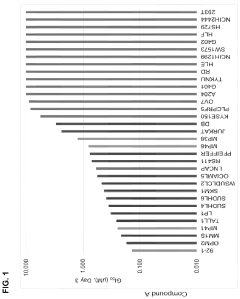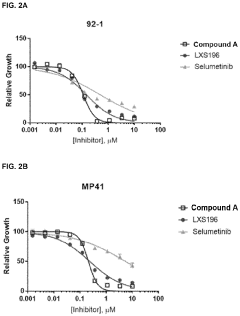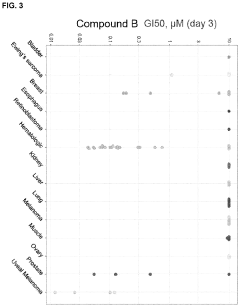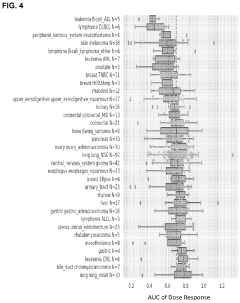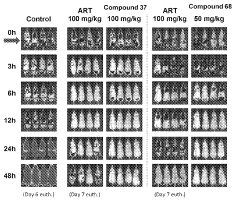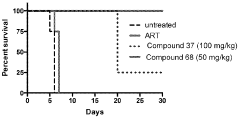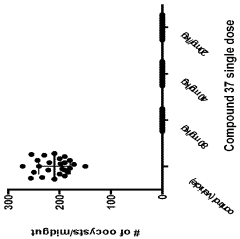Role of Geometric Isomers in Crystallographic Studies
AUG 1, 20259 MIN READ
Generate Your Research Report Instantly with AI Agent
Patsnap Eureka helps you evaluate technical feasibility & market potential.
Geometric Isomers in Crystallography: Background and Objectives
Geometric isomers have played a crucial role in the field of crystallography since its inception. These molecular structures, which possess the same chemical formula but differ in the spatial arrangement of their atoms, have been instrumental in advancing our understanding of crystal structures and their properties. The study of geometric isomers in crystallography dates back to the early 20th century when scientists first began to unravel the complexities of molecular arrangements within crystals.
The evolution of this field has been marked by significant technological advancements, from early X-ray diffraction techniques to modern synchrotron radiation and neutron scattering methods. These developments have enabled researchers to probe the intricate details of geometric isomers within crystal lattices with unprecedented precision. As our ability to analyze and manipulate these structures has improved, so too has our comprehension of their impact on material properties and chemical reactivity.
In recent years, the importance of geometric isomers in crystallographic studies has gained renewed attention due to their implications in various scientific and industrial applications. From pharmaceutical development to materials science, the ability to control and predict the behavior of geometric isomers in crystalline structures has become a key focus for researchers and industry professionals alike.
The primary objective of studying geometric isomers in crystallography is to elucidate the relationship between molecular structure and macroscopic properties of crystalline materials. This includes understanding how different isomeric forms influence crystal packing, stability, and physicochemical characteristics. By gaining insights into these relationships, researchers aim to develop more effective strategies for crystal engineering and design of functional materials.
Another critical goal is to enhance our predictive capabilities in crystal structure determination. As the complexity of molecular systems continues to grow, the ability to accurately model and anticipate the crystallization behavior of geometric isomers becomes increasingly valuable. This is particularly relevant in fields such as drug development, where polymorphism and isomerism can significantly impact the efficacy and bioavailability of pharmaceutical compounds.
Furthermore, the study of geometric isomers in crystallography seeks to bridge the gap between molecular-level interactions and macroscopic material properties. By elucidating the subtle differences in crystal packing and intermolecular forces among isomers, researchers hope to gain a more comprehensive understanding of structure-property relationships in crystalline materials.
The evolution of this field has been marked by significant technological advancements, from early X-ray diffraction techniques to modern synchrotron radiation and neutron scattering methods. These developments have enabled researchers to probe the intricate details of geometric isomers within crystal lattices with unprecedented precision. As our ability to analyze and manipulate these structures has improved, so too has our comprehension of their impact on material properties and chemical reactivity.
In recent years, the importance of geometric isomers in crystallographic studies has gained renewed attention due to their implications in various scientific and industrial applications. From pharmaceutical development to materials science, the ability to control and predict the behavior of geometric isomers in crystalline structures has become a key focus for researchers and industry professionals alike.
The primary objective of studying geometric isomers in crystallography is to elucidate the relationship between molecular structure and macroscopic properties of crystalline materials. This includes understanding how different isomeric forms influence crystal packing, stability, and physicochemical characteristics. By gaining insights into these relationships, researchers aim to develop more effective strategies for crystal engineering and design of functional materials.
Another critical goal is to enhance our predictive capabilities in crystal structure determination. As the complexity of molecular systems continues to grow, the ability to accurately model and anticipate the crystallization behavior of geometric isomers becomes increasingly valuable. This is particularly relevant in fields such as drug development, where polymorphism and isomerism can significantly impact the efficacy and bioavailability of pharmaceutical compounds.
Furthermore, the study of geometric isomers in crystallography seeks to bridge the gap between molecular-level interactions and macroscopic material properties. By elucidating the subtle differences in crystal packing and intermolecular forces among isomers, researchers hope to gain a more comprehensive understanding of structure-property relationships in crystalline materials.
Market Demand for Geometric Isomer Analysis
The market demand for geometric isomer analysis in crystallographic studies has been steadily growing, driven by the increasing importance of understanding molecular structures in various scientific and industrial applications. Pharmaceutical companies, in particular, have shown a significant interest in this field, as geometric isomers can exhibit different biological activities and pharmacological properties. The ability to accurately identify and characterize geometric isomers is crucial for drug development, quality control, and regulatory compliance.
In the chemical industry, geometric isomer analysis plays a vital role in the production of polymers, catalysts, and other specialty chemicals. The demand for high-purity isomers has led to increased investment in analytical techniques and technologies that can distinguish between different geometric configurations. This trend is expected to continue as manufacturers seek to optimize their processes and develop more efficient and sustainable products.
The food and beverage industry has also recognized the importance of geometric isomer analysis, particularly in the study of natural flavors and fragrances. As consumers demand cleaner labels and more natural ingredients, companies are investing in advanced analytical methods to ensure the authenticity and quality of their products. This has created a niche market for specialized analytical services and equipment tailored to the food industry's needs.
Academic research institutions and government laboratories contribute significantly to the market demand for geometric isomer analysis. These organizations are at the forefront of developing new analytical techniques and exploring the fundamental properties of geometric isomers. Their work often translates into commercial applications, driving innovation in the field and creating new market opportunities.
The environmental sector has emerged as another key driver of demand for geometric isomer analysis. As regulatory bodies worldwide implement stricter environmental monitoring and remediation standards, there is a growing need for accurate identification and quantification of geometric isomers in environmental samples. This has led to the development of more sensitive and robust analytical methods, as well as increased demand for environmental testing services.
In the materials science field, geometric isomer analysis is becoming increasingly important for the development of advanced materials with specific properties. From liquid crystals to organic semiconductors, understanding the spatial arrangement of molecules is crucial for optimizing material performance. This has created a demand for sophisticated analytical tools and expertise in geometric isomer characterization among materials researchers and manufacturers.
In the chemical industry, geometric isomer analysis plays a vital role in the production of polymers, catalysts, and other specialty chemicals. The demand for high-purity isomers has led to increased investment in analytical techniques and technologies that can distinguish between different geometric configurations. This trend is expected to continue as manufacturers seek to optimize their processes and develop more efficient and sustainable products.
The food and beverage industry has also recognized the importance of geometric isomer analysis, particularly in the study of natural flavors and fragrances. As consumers demand cleaner labels and more natural ingredients, companies are investing in advanced analytical methods to ensure the authenticity and quality of their products. This has created a niche market for specialized analytical services and equipment tailored to the food industry's needs.
Academic research institutions and government laboratories contribute significantly to the market demand for geometric isomer analysis. These organizations are at the forefront of developing new analytical techniques and exploring the fundamental properties of geometric isomers. Their work often translates into commercial applications, driving innovation in the field and creating new market opportunities.
The environmental sector has emerged as another key driver of demand for geometric isomer analysis. As regulatory bodies worldwide implement stricter environmental monitoring and remediation standards, there is a growing need for accurate identification and quantification of geometric isomers in environmental samples. This has led to the development of more sensitive and robust analytical methods, as well as increased demand for environmental testing services.
In the materials science field, geometric isomer analysis is becoming increasingly important for the development of advanced materials with specific properties. From liquid crystals to organic semiconductors, understanding the spatial arrangement of molecules is crucial for optimizing material performance. This has created a demand for sophisticated analytical tools and expertise in geometric isomer characterization among materials researchers and manufacturers.
Current Challenges in Geometric Isomer Crystallography
The field of geometric isomer crystallography faces several significant challenges that hinder progress and limit our understanding of these complex molecular structures. One of the primary obstacles is the difficulty in accurately predicting and controlling the crystallization behavior of geometric isomers. The subtle differences in molecular geometry can lead to unpredictable packing arrangements, making it challenging to design and synthesize crystals with desired properties.
Another major challenge lies in the characterization of geometric isomers within crystal structures. Traditional X-ray diffraction techniques often struggle to distinguish between closely related isomers, especially when dealing with mixtures or disordered systems. This limitation can result in ambiguous structural determinations and incomplete understanding of the crystal's composition and properties.
The polymorphism of geometric isomers presents yet another hurdle in crystallographic studies. Different crystal forms of the same isomer can exhibit varying physical and chemical properties, complicating efforts to develop consistent and reliable crystallization protocols. Researchers must navigate the complex landscape of polymorphic forms to ensure reproducibility and control over crystal properties.
Furthermore, the dynamic nature of some geometric isomers poses challenges in crystallographic analysis. Isomers that can interconvert or undergo conformational changes within the crystal lattice can lead to structural disorder and complicate data interpretation. Capturing and characterizing these dynamic processes requires advanced experimental techniques and sophisticated data analysis methods.
The influence of external factors on geometric isomer crystallization also presents significant challenges. Environmental conditions such as temperature, pressure, and solvent effects can dramatically impact the crystallization process and the resulting crystal structures. Understanding and controlling these variables is crucial for reproducible crystal growth and accurate structural determination.
Lastly, the integration of computational methods with experimental techniques remains a challenge in geometric isomer crystallography. While computational approaches offer powerful tools for predicting crystal structures and properties, bridging the gap between theoretical predictions and experimental observations often proves difficult. Improving the accuracy and reliability of computational models for geometric isomers is an ongoing area of research that requires further development.
Another major challenge lies in the characterization of geometric isomers within crystal structures. Traditional X-ray diffraction techniques often struggle to distinguish between closely related isomers, especially when dealing with mixtures or disordered systems. This limitation can result in ambiguous structural determinations and incomplete understanding of the crystal's composition and properties.
The polymorphism of geometric isomers presents yet another hurdle in crystallographic studies. Different crystal forms of the same isomer can exhibit varying physical and chemical properties, complicating efforts to develop consistent and reliable crystallization protocols. Researchers must navigate the complex landscape of polymorphic forms to ensure reproducibility and control over crystal properties.
Furthermore, the dynamic nature of some geometric isomers poses challenges in crystallographic analysis. Isomers that can interconvert or undergo conformational changes within the crystal lattice can lead to structural disorder and complicate data interpretation. Capturing and characterizing these dynamic processes requires advanced experimental techniques and sophisticated data analysis methods.
The influence of external factors on geometric isomer crystallization also presents significant challenges. Environmental conditions such as temperature, pressure, and solvent effects can dramatically impact the crystallization process and the resulting crystal structures. Understanding and controlling these variables is crucial for reproducible crystal growth and accurate structural determination.
Lastly, the integration of computational methods with experimental techniques remains a challenge in geometric isomer crystallography. While computational approaches offer powerful tools for predicting crystal structures and properties, bridging the gap between theoretical predictions and experimental observations often proves difficult. Improving the accuracy and reliability of computational models for geometric isomers is an ongoing area of research that requires further development.
Existing Methods for Geometric Isomer Characterization
01 Synthesis and separation of geometric isomers
Methods for synthesizing and separating geometric isomers, including techniques for controlling the formation of specific isomers during chemical reactions and purification processes to isolate desired isomers from mixtures.- Synthesis and separation of geometric isomers: Methods for synthesizing and separating geometric isomers are crucial in organic chemistry. These techniques involve various reaction conditions, catalysts, and purification processes to obtain specific isomers. Separation methods may include chromatography, crystallization, or selective complexation.
- Geometric isomers in pharmaceutical compounds: Geometric isomerism plays a significant role in pharmaceutical compounds, affecting their biological activity and efficacy. Research focuses on identifying and isolating specific isomers with desired therapeutic properties, as well as studying their metabolism and potential side effects.
- Analytical methods for geometric isomers: Various analytical techniques are employed to identify, characterize, and quantify geometric isomers. These methods include spectroscopic techniques such as NMR, IR, and UV-Vis spectroscopy, as well as chromatographic methods like HPLC and GC. Advanced computational tools are also used for structural analysis and prediction.
- Geometric isomers in materials science: The study of geometric isomers extends to materials science, where isomerism can influence the properties of polymers, liquid crystals, and other advanced materials. Research in this area focuses on controlling isomer ratios to optimize material characteristics for specific applications.
- Computational modeling of geometric isomers: Advanced computational techniques are used to model and predict the behavior of geometric isomers. These methods include molecular dynamics simulations, quantum mechanical calculations, and machine learning approaches to understand isomer stability, reactivity, and properties.
02 Characterization and analysis of geometric isomers
Techniques for identifying and analyzing geometric isomers, including spectroscopic methods, chromatography, and computational approaches to determine the structure and properties of different isomeric forms.Expand Specific Solutions03 Applications of geometric isomers in pharmaceuticals
Utilization of geometric isomers in drug development and formulation, focusing on the impact of isomerism on drug efficacy, safety, and pharmacokinetics, as well as strategies for optimizing isomer selection in pharmaceutical products.Expand Specific Solutions04 Geometric isomers in materials science and engineering
Exploration of geometric isomerism in the context of materials science, including the effects of isomeric structures on material properties, performance, and applications in various fields such as polymers, liquid crystals, and nanotechnology.Expand Specific Solutions05 Computational modeling and prediction of geometric isomers
Development and application of computational methods for modeling geometric isomers, including algorithms for predicting isomer stability, reactivity, and properties, as well as visualization techniques for representing isomeric structures.Expand Specific Solutions
Key Players in Crystallographic Research and Industry
The field of geometric isomers in crystallographic studies is in a mature stage of development, with a well-established market and significant technological advancements. The global market size for crystallography is estimated to be in the billions of dollars, driven by applications in pharmaceuticals, materials science, and biotechnology. Companies like Genentech, Novartis, and GlaxoSmithKline are at the forefront of utilizing this technology in drug discovery and development. Academic institutions such as Academia Sinica and National Taiwan University contribute to fundamental research, while specialized firms like Sentinel Oncology and Foghorn Therapeutics leverage crystallographic insights for targeted drug design. The technology's maturity is evident in its widespread adoption across industry and academia, with ongoing refinements focused on improving resolution and data analysis techniques.
Genentech, Inc.
Technical Solution: Genentech has developed advanced crystallographic techniques to study geometric isomers in protein structures. They utilize high-resolution X-ray crystallography combined with computational modeling to analyze the spatial arrangements of atoms in isomeric compounds. This approach allows for precise determination of bond angles, lengths, and three-dimensional conformations of geometric isomers[1]. Their method incorporates synchrotron radiation sources for enhanced data collection, enabling the differentiation of subtle structural variations between isomers. Genentech also employs cryo-electron microscopy to complement X-ray studies, providing insights into isomer dynamics in solution[3].
Strengths: High-resolution structural analysis, integration of multiple techniques. Weaknesses: Resource-intensive process, potential limitations in studying highly dynamic isomers.
Glaxo Group Ltd.
Technical Solution: Glaxo Group has pioneered the use of neutron crystallography in studying geometric isomers, particularly in drug development. Their approach focuses on hydrogen atom positions, which are crucial in distinguishing between isomers. By using neutron diffraction, they can accurately locate hydrogen atoms, providing detailed information about bond orientations and isomeric configurations[2]. This method is complemented by their proprietary software for data analysis, which can identify and characterize subtle differences in isomeric structures. Glaxo's technique is particularly valuable in understanding drug-target interactions where isomerization plays a key role[4].
Strengths: Precise hydrogen atom localization, specialized in pharmaceutical applications. Weaknesses: Limited to compounds suitable for neutron diffraction, requires specialized facilities.
Innovative Approaches in Geometric Isomer Crystal Studies
Compounds and uses thereof
PatentPendingUS20230145003A1
Innovation
- Development of specific compounds that modulate the BAF complex by inhibiting BRG1 and/or BRM activity, which can be used alone or in combination with other pharmaceutically active agents to treat disorders like cancer.
Compounds and methods for the treatment of malaria
PatentInactiveIN202118043692A
Innovation
- Development of specific compounds, such as those represented by Formula I and listed in Table 1, which offer new structural features and functional groups to target malaria parasites effectively, including those resistant to existing drugs.
Regulatory Framework for Crystallographic Studies
The regulatory framework for crystallographic studies involving geometric isomers is a complex and evolving landscape that encompasses various aspects of research, safety, and ethical considerations. At the international level, organizations such as the International Union of Crystallography (IUCr) play a crucial role in establishing guidelines and best practices for crystallographic research. These guidelines often address issues related to data collection, analysis, and reporting, ensuring the reliability and reproducibility of crystallographic studies involving geometric isomers.
National regulatory bodies, such as the Food and Drug Administration (FDA) in the United States and the European Medicines Agency (EMA) in Europe, have established specific requirements for the characterization and analysis of geometric isomers in pharmaceutical compounds. These regulations are particularly important in drug development, where the precise identification and quantification of geometric isomers can significantly impact drug efficacy and safety profiles.
In academic research settings, institutional review boards (IRBs) and research ethics committees often oversee studies involving geometric isomers, especially when these studies have potential implications for human health or environmental safety. These committees ensure that research protocols adhere to ethical standards and comply with relevant regulations, including those related to the handling and disposal of potentially hazardous materials.
Environmental regulations also play a role in crystallographic studies of geometric isomers, particularly when these studies involve substances that may pose risks to ecosystems. Agencies such as the Environmental Protection Agency (EPA) in the United States and the European Chemicals Agency (ECHA) in Europe have established guidelines for the assessment and management of chemical risks, which may include specific provisions for geometric isomers.
The regulatory framework also extends to the realm of intellectual property. Patent offices worldwide have developed specific guidelines for the patenting of crystal forms, including those involving geometric isomers. These guidelines often require detailed characterization of the crystal structures and their properties, as well as clear differentiation from known forms.
As the field of crystallography continues to advance, regulatory frameworks are adapting to address new challenges and opportunities. For instance, the increasing use of artificial intelligence and machine learning in crystallographic studies has prompted discussions about data privacy, algorithm transparency, and the validation of AI-assisted results. Regulatory bodies are working to develop guidelines that balance innovation with the need for scientific rigor and reproducibility.
In conclusion, the regulatory framework for crystallographic studies of geometric isomers is multifaceted, involving international organizations, national regulatory agencies, institutional oversight, and evolving guidelines that reflect the dynamic nature of the field. Researchers and organizations engaged in such studies must navigate this complex landscape to ensure compliance, maintain ethical standards, and contribute to the advancement of crystallographic science.
National regulatory bodies, such as the Food and Drug Administration (FDA) in the United States and the European Medicines Agency (EMA) in Europe, have established specific requirements for the characterization and analysis of geometric isomers in pharmaceutical compounds. These regulations are particularly important in drug development, where the precise identification and quantification of geometric isomers can significantly impact drug efficacy and safety profiles.
In academic research settings, institutional review boards (IRBs) and research ethics committees often oversee studies involving geometric isomers, especially when these studies have potential implications for human health or environmental safety. These committees ensure that research protocols adhere to ethical standards and comply with relevant regulations, including those related to the handling and disposal of potentially hazardous materials.
Environmental regulations also play a role in crystallographic studies of geometric isomers, particularly when these studies involve substances that may pose risks to ecosystems. Agencies such as the Environmental Protection Agency (EPA) in the United States and the European Chemicals Agency (ECHA) in Europe have established guidelines for the assessment and management of chemical risks, which may include specific provisions for geometric isomers.
The regulatory framework also extends to the realm of intellectual property. Patent offices worldwide have developed specific guidelines for the patenting of crystal forms, including those involving geometric isomers. These guidelines often require detailed characterization of the crystal structures and their properties, as well as clear differentiation from known forms.
As the field of crystallography continues to advance, regulatory frameworks are adapting to address new challenges and opportunities. For instance, the increasing use of artificial intelligence and machine learning in crystallographic studies has prompted discussions about data privacy, algorithm transparency, and the validation of AI-assisted results. Regulatory bodies are working to develop guidelines that balance innovation with the need for scientific rigor and reproducibility.
In conclusion, the regulatory framework for crystallographic studies of geometric isomers is multifaceted, involving international organizations, national regulatory agencies, institutional oversight, and evolving guidelines that reflect the dynamic nature of the field. Researchers and organizations engaged in such studies must navigate this complex landscape to ensure compliance, maintain ethical standards, and contribute to the advancement of crystallographic science.
Environmental Impact of Geometric Isomer Research
The environmental impact of geometric isomer research in crystallographic studies is a multifaceted issue that warrants careful consideration. The use of various solvents and chemicals in the synthesis and purification of geometric isomers can potentially lead to environmental contamination if not properly managed. These processes often involve organic solvents, which may be toxic or harmful to ecosystems if released into the environment. Additionally, the energy-intensive nature of some crystallization techniques used in isomer separation contributes to increased carbon emissions.
However, advancements in green chemistry practices have begun to mitigate these concerns. Researchers are increasingly adopting more environmentally friendly solvents and developing solvent-free crystallization methods. These approaches not only reduce the environmental footprint of isomer research but also often lead to more efficient and cost-effective processes.
The study of geometric isomers in crystallography has also contributed positively to environmental science. Understanding the structural differences between isomers has led to improvements in the design of environmentally friendly materials. For instance, research into the crystalline structures of geometric isomers has aided in the development of more effective catalysts for pollution control and waste treatment processes.
Moreover, the knowledge gained from geometric isomer research has applications in the field of environmental monitoring. Crystallographic studies of isomers have enhanced our ability to detect and identify environmental pollutants, particularly in cases where different isomers of the same compound have varying levels of toxicity or persistence in the environment.
In the realm of pharmaceuticals, geometric isomer research has led to the development of more targeted and efficient drugs. This has indirect environmental benefits, as it can result in reduced pharmaceutical waste and lower concentrations of drug residues in water systems. Similarly, in the agrochemical industry, understanding the crystalline properties of geometric isomers has enabled the creation of more effective and environmentally benign pesticides and herbicides.
The impact of this research extends to the field of materials science, where insights into geometric isomerism have facilitated the development of new materials with enhanced biodegradability or recyclability. This contributes to efforts in reducing plastic pollution and promoting sustainable material use.
In conclusion, while geometric isomer research in crystallography does pose some environmental challenges, particularly in terms of chemical use and energy consumption, its overall impact is increasingly positive. The field continues to evolve towards more sustainable practices, and the knowledge gained from these studies is instrumental in addressing various environmental issues across multiple sectors.
However, advancements in green chemistry practices have begun to mitigate these concerns. Researchers are increasingly adopting more environmentally friendly solvents and developing solvent-free crystallization methods. These approaches not only reduce the environmental footprint of isomer research but also often lead to more efficient and cost-effective processes.
The study of geometric isomers in crystallography has also contributed positively to environmental science. Understanding the structural differences between isomers has led to improvements in the design of environmentally friendly materials. For instance, research into the crystalline structures of geometric isomers has aided in the development of more effective catalysts for pollution control and waste treatment processes.
Moreover, the knowledge gained from geometric isomer research has applications in the field of environmental monitoring. Crystallographic studies of isomers have enhanced our ability to detect and identify environmental pollutants, particularly in cases where different isomers of the same compound have varying levels of toxicity or persistence in the environment.
In the realm of pharmaceuticals, geometric isomer research has led to the development of more targeted and efficient drugs. This has indirect environmental benefits, as it can result in reduced pharmaceutical waste and lower concentrations of drug residues in water systems. Similarly, in the agrochemical industry, understanding the crystalline properties of geometric isomers has enabled the creation of more effective and environmentally benign pesticides and herbicides.
The impact of this research extends to the field of materials science, where insights into geometric isomerism have facilitated the development of new materials with enhanced biodegradability or recyclability. This contributes to efforts in reducing plastic pollution and promoting sustainable material use.
In conclusion, while geometric isomer research in crystallography does pose some environmental challenges, particularly in terms of chemical use and energy consumption, its overall impact is increasingly positive. The field continues to evolve towards more sustainable practices, and the knowledge gained from these studies is instrumental in addressing various environmental issues across multiple sectors.
Unlock deeper insights with Patsnap Eureka Quick Research — get a full tech report to explore trends and direct your research. Try now!
Generate Your Research Report Instantly with AI Agent
Supercharge your innovation with Patsnap Eureka AI Agent Platform!
